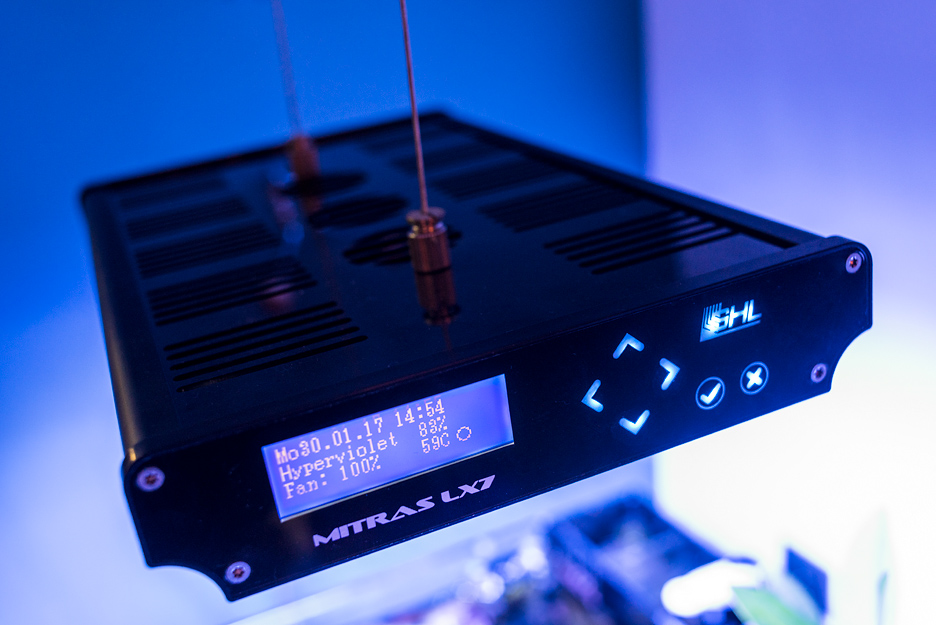
The GHL Mitras LX7 LED Light for Reef Aquariums – Review
Full disclosure before we get into this review. I’m a HUGE fan of the Metal Halide/T5 Combo when it comes to saltwater reef lighting, especially when the goal is to grow vibrant healthy SPS coral. I’ve always considered it king, and LED just wasn’t up to “par”. Come on… you have to allow me at least ONE lighting joke in a lighting review. 😉
Enter the GHL Mitras LX7.
When I received the GHL Mitras LX7 it was going to replace a Reefbrite MH fixture. Less heat, lower power consumption, and more control. The question was how would my coral react? And how does this light stand up to other high-end LED options?
Build Quality
Upon arrival and taking the Mitras out of the box, it immediately felt like a GHL product. It feels very solid/sturdy. Metal construction. The screen is on the short end along with the capacitive touch controls. If you are familiar with the GHL Profilux controller you will feel right at home. Same screen with the same kind of controls and menu system. When you are paying top tier prices, it’s nice to receive a product that feels top tier.
Appearance and Design
You can get the basic gist by looking at their photos online, but in person, it’s a pretty sleek bit of kit. I opted for black, and there is a white option as well.
The bottom panel is where the magic happens… Six clusters of LEDs recessed slightly within reflectors (yes… REFLECTORS) and finished off with a sheet of acrylic, making the entire bottom panel one smooth surface. And finally, GHL couldn’t just use a standard black rubber sheathing over the single electrical cord. They used a transparent casing, revealing the silver wire inside. It’s clean, and it doesn’t stand out as much as a black cord would. The top of the Mitras is vented and contains three small fans which are completely silent. To these ears anyway.

Programming
You can do this with the screen and capacitive touch buttons on the Mitras itself but it would be a chore. The best course of action is to use the PC based software, GHL Control Center. The initial connection to your Mitras has to be with the provided USB cable. GHL has a youtube channel and they show you step by step how to connect and get hooked up to your WiFi. It’s pretty simple and the video makes it a cinch. From then on you can connect to the Mitras wirelessly.
Once connected you can open up the software, go to the Illumination tab, and create a new “project”. Honestly, I’m still learning what the software can do. It’s VERY capable with lots of nice options. But creating your initial project is very easy. Start by creating your first time-point for the day. You’ll see the familiar sliders for each color channel. Choose the percent power for each color channel, click ok and create the next point on the graph. Pretty standard stuff.

Other nice little programming features…
- You can choose to see your programming changes on the fly… or not.
- You can save spectrum presets, very helpful while programming your daily schedule.
- You can set up several “maintenance” programs. Maintenance Programs are easily accessed through the pc software, the cloud, or directly on the light with just a few clicks. For instance, I set up a 13,000k spectrum for taking photos of my coral.
- Feel like you need a little more punch out of a color channel? You can “overdrive” it up to 130%.
- Detailed “Simulation” modes for clouds, rainy days, and moon phases, all tweakable to your liking.
- Thunderstorms can be simulated, with a ton of options, even SOUND! But the sound comes out of your PC, not the Mitras.
- You can even simulate Seasonal Lighting… day length and intensity changes throughout the year.
I have to say, the details and options available are really impressive. The more I use it, the more I like it, and in many ways prefer it over other lights that I’ve used. And it can all be done without being connected to a cloud service, but the cloud option is available which is nice for making changes remotely.
Light Quality
You get 9 separate, dimmable color channels to work with. Hyper Violet, Ultra Violet, Royal Blue, Blue, Blue White, Cool White, Warm White, True Green, and Hyper Red. Wow. There’s a total of 72 LEDs spread across 6 clusters. Each cluster is replaceable/upgradeable and the LEDs are clustered very tight together. Each puck contains a metal coated reflector that attempts to mimic parabolic metal halide reflectors. Reflectors blend the color channels to avoid the “disco” effect commonly seen in tanks that are lit by led fixtures. I can say that I see zero disco effect in my tank.
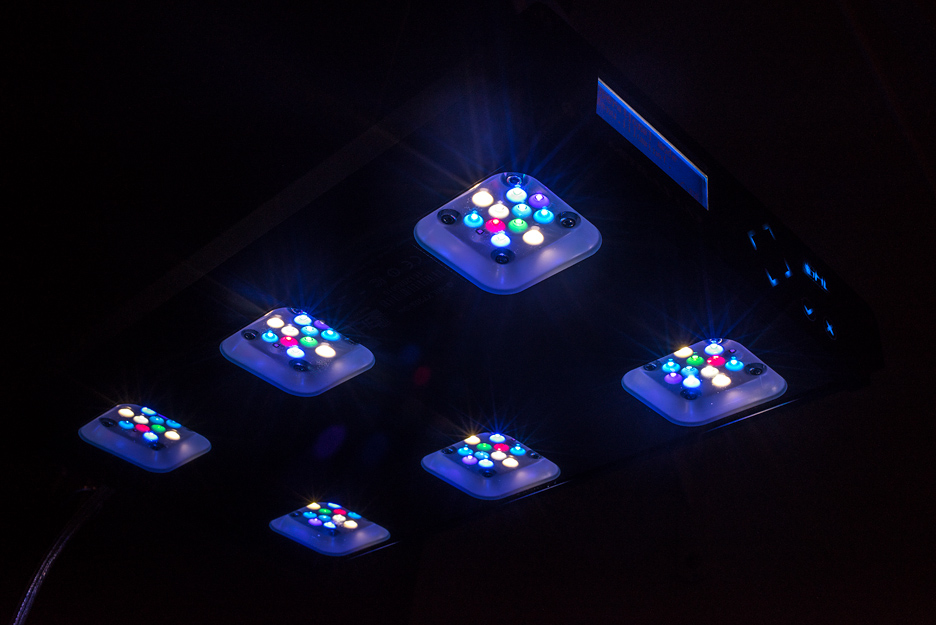
The light spread and lack of shadowing
PAR
Here we have a quick PAR measurement at different levels across the width of the tank. Just beneath the surface of the water, middle, and sand bed. The black numbers represent the very bottom of the tank but close to the front glass. The further down we go, the less light fall-off there is on the ends. In other words, more even light spread. This is why I like to hang the lights high. More even light and less shadowing.

Also note that when hanging above the aquarium, the lack of glare and light spill is impressive. Again, the GHL Mitras LX7 is 14″ off the surface of the water. When in a sitting position, I can see all 6 pucks, yet I have no problem looking right at them from this angle. With the light spread this unit has, this is impressive, to say the least.
Colors
I think we can agree that the majority of reefers want their coral to have good color. Assuming you’ve got everything else dialed in, you’re going to want your light to bring out those colors, and you will not be disappointed. With 9 channels, including two whites and several blues/purples, you are sure to find a spectrum (or two or three) that suit your needs. I prefer a whiter light with a bit of crisp blue, similar to Radium 14k MH bulbs.
A few weeks under the GHL Mitras LX7 and my corals are looking vibrant and healthy. Get your’s here and experience what is easily one of the




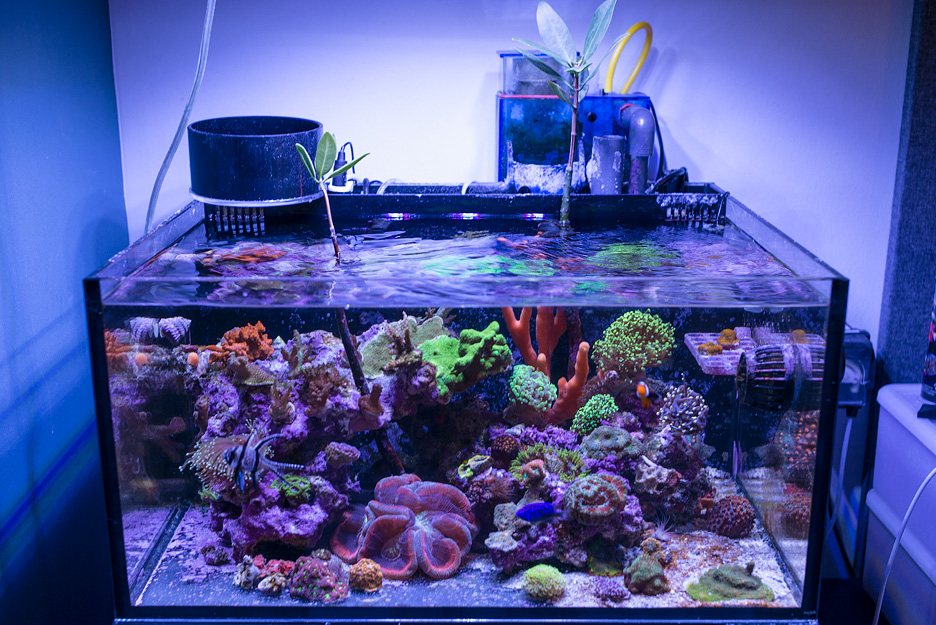
Author’s Note: This was a previously-posted review from a past blog of ours. If anything is outdated, please contact us so we can get this updated with the most current and correct information.
I sometimes link directly to products and services that I REALLY like and think you may enjoy or find useful as well. If you buy them, I may get a small share of the revenue from the sale from our partners.





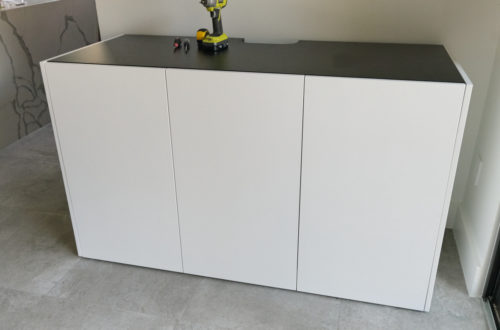
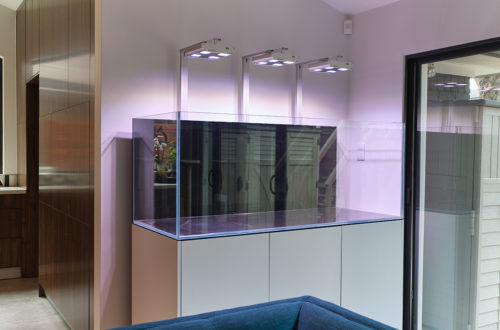
4 Comments
David
Can you post new picture ?
I want to see the evolution and are you satified yet of the mitras ?
Thanks
admin
Hi David! Sorry, I know it’s a little confusing but this was an older article from my previous blog that I reposted here. I had to take this office tank down so unfortunately, I don’t have any recent updates. But what I can tell you is that I was very happy with these lamps. I was able to compare them to my Radions that were running on the home tank and I would easily recommend either when it comes to growing SPS coral. In fact, I’m going to be starting a freshwater planted build here very soon, and I will be using the freshwater version of the Mitras for my lighting. I’m a big fan of GHL equipment as a whole. Build quality and robust firmware/software are always top notch.
stéphane quennevat
hello,
I am interesting by the Mitras Flex mount system . How thick is the mount near the wall.?
I believe iThe flex mount piece that goes behind the tank is 1.75″L x 0.75″W x 60″ H.
Thanks to confirm the thickness 0.75 ?
Thanks to your help,
Best regards,
stéphane
admin
Hi Stéphane, the thickness is 0.75″ as stated. Hope that helps!